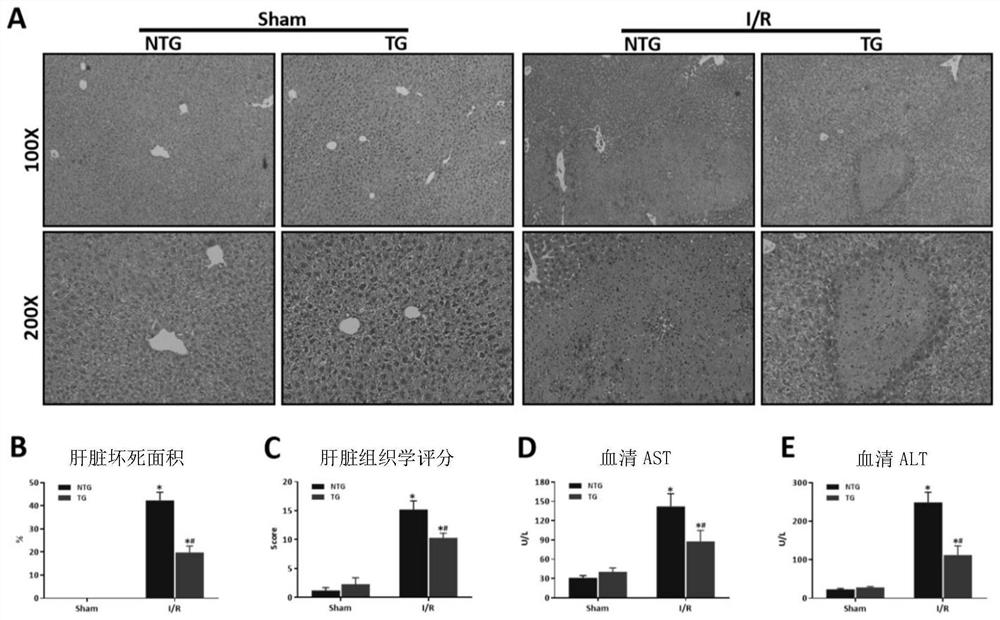Application of heat shock factor 2 binding protein in liver ischemia-reperfusion injury and drug-induced liver injury
A technology for drug-induced liver injury and reperfusion injury, applied in the field of gene function and application, can solve the problems of unclear role of liver disease and little research.
- Summary
- Abstract
- Description
- Claims
- Application Information
AI Technical Summary
Problems solved by technology
Method used
Image
Examples
Embodiment 1
[0030] [Example 1] Construction of liver cell-specific HSF2BP overexpression and knockout mice:
[0031] To further study the effect of HSF2BP overexpression on liver ischemia-reperfusion injury, we constructed liver-specific HSF2BP overexpression (TG) and knockout (KO) mice. Real-time quantitative PCR (q-PCR) experiments found that the expression of HSF2BP gene in the liver of overexpression mice was significantly increased, while the expression of HSF2BP gene in the liver of knockout mice was significantly decreased (such as figure 1 Middle A, B).
Embodiment 2
[0032] [Example 2] Construction of mouse liver ischemia-reperfusion injury model:
[0033]1. Grouping of experimental animals: male TG, NTG, KO and WT mice aged 8-12 weeks and weighing 20-25g were used as research objects, and divided into 8 groups, namely sham mice with HSF2BP overexpression and non-overexpression mice Operated (NTG-Sham and TG-Sham) and surgical groups (NTG-I / R and TG-I / R); sham-operated (WT-Sham and KO-Sham) of HSF2BP knockout mice and wild-type mice and In the operation group (WT-I / R and KO-I / R), the model of liver ischemia-reperfusion injury was established.
[0034] 2. Operation procedure of liver ischemia-reperfusion injury model:
[0035] 1) The mice were fasted 12 hours before the operation and had free access to water.
[0036] 2) After isoflurane inhalation anesthesia, the patients were fixed in supine position, the abdominal hair was shaved and disinfected.
[0037] 3) Take an incision about 3 cm from the center of the abdomen and enter the abdo...
Embodiment 3
[0040] [Example 3] Construction of a drug-induced liver injury model in mice:
[0041] 1. Grouping of experimental animals: male TG, NTG, KO and WT mice aged 8-12 weeks and weighing 20-25g were used as research objects, and divided into 8 groups, namely sham mice with HSF2BP overexpression and non-overexpression mice Surgery (NTG-Sham and TG-Sham) and model group (NTG-APAP and TG-APAP); sham operation (WT-Sham and KO-Sham) and model group of HSF2BP knockout mice and wild-type mice (WT-APAP and KO-APAP), and then establish a drug-induced liver injury model.
[0042] 2. The operation process of the drug-induced liver injury model:
[0043] 1) The mice were fasted 12 hours before the administration and allowed to drink water freely.
[0044] 2) After the injection site was sterilized, APAP (500 mg / kg) was injected intraperitoneally.
[0045] 3) Collect mouse serum and liver samples 6 hours after administration.
PUM
 Login to View More
Login to View More Abstract
Description
Claims
Application Information
 Login to View More
Login to View More - R&D
- Intellectual Property
- Life Sciences
- Materials
- Tech Scout
- Unparalleled Data Quality
- Higher Quality Content
- 60% Fewer Hallucinations
Browse by: Latest US Patents, China's latest patents, Technical Efficacy Thesaurus, Application Domain, Technology Topic, Popular Technical Reports.
© 2025 PatSnap. All rights reserved.Legal|Privacy policy|Modern Slavery Act Transparency Statement|Sitemap|About US| Contact US: help@patsnap.com



